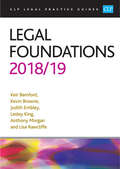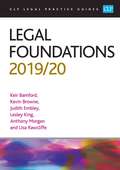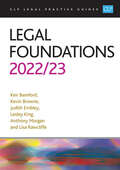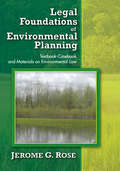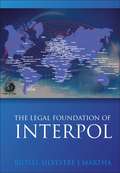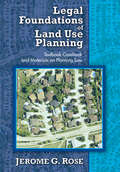- Table View
- List View
Legal Form and the End of Law: Pashukanis's Legacy (Nomos Studies in Law, Culture and Power)
by Cosmin Cercel Gian-Giacomo Fusco Przemysław TacikFollowing the 100th anniversary of Pashukanis’ General Theory of Law and Marxism (1924), this volume aims to breathe new life into the main category of Pashukanian legacy, the concept of legal form. This book offers new, deeper and more general, ways in which the concept of legal form can be used to push forward Marxist – post-Marxist or hauntingly Marxist – legal theory. Accordingly, this book does not pledge allegiance to reconstructing and reconsidering the official interpretative legacy of the legal form. Instead, it mobilises the revolutionary conceptual potentialities that this term contains. When investigated thoroughly, and in many dimensions, the legal form becomes a privileged vantage point not only into the greatest law-related riddles of Marxism (such as the relation between economy and the state or withering away of statal apparatuses), but the whole of modernity as the epoch determined by – if not overlapping with – capitalism. This book aims to think with the legal form rather than explain this concept. In so doing, it offers a panoply of theoretical perspectives that address legal subjectivity, abstraction, autonomy of the law and, last but not least, withering away of the law. This contemporary interrogation of the relevance of the concept of legal form will be of considerable interest to scholars and students of legal and political theory.
Legal Form and the End of Law: Pashukanis's Legacy (Nomos Studies in Law, Culture and Power)
by Cosmin Cercel Gian-Giacomo Fusco Przemyslaw TacikFollowing the 100th anniversary of Pashukanis’ General Theory of Law and Marxism (1924), this volume aims to breathe new life into the main category of Pashukanian legacy, the concept of legal form. This book offers new, deeper and more general, ways in which the concept of legal form can be used to push forward Marxist – post-Marxist or hauntingly Marxist – legal theory. Accordingly, this book does not pledge allegiance to reconstructing and reconsidering the official interpretative legacy of the legal form. Instead, it mobilises the revolutionary conceptual potentialities that this term contains. When investigated thoroughly, and in many dimensions, the legal form becomes a privileged vantage point not only into the greatest law-related riddles of Marxism (such as the relation between economy and the state or withering away of statal apparatuses), but the whole of modernity as the epoch determined by – if not overlapping with – capitalism. This book aims to think with the legal form rather than explain this concept. In so doing, it offers a panoply of theoretical perspectives that address legal subjectivity, abstraction, autonomy of the law and, last but not least, withering away of the law. This contemporary interrogation of the relevance of the concept of legal form will be of considerable interest to scholars and students of legal and political theory.
Legal Foundations 2018/19
by Keir Bamford Kevin Browne L. C. KingLegal Foundations provides a practical introduction to five subjects that are an intrinsic part of legal practice and which must be clearly understood by all practitioners: Revenue Law, Professional Conduct, EC Law, Human Rights and Probate and Administration. Worked examples illustrate how these topics are applied in practice.
Legal Foundations 2018/19
by Keir Bamford Kevin Browne L. C. KingLegal Foundations provides a practical introduction to five subjects that are an intrinsic part of legal practice and which must be clearly understood by all practitioners: Revenue Law, Professional Conduct, EC Law, Human Rights and Probate and Administration. Worked examples illustrate how these topics are applied in practice.
Legal Foundations 2019/20
by Keir Bamford Kevin Browne L. C. KingLegal Foundations provides a practical introduction to five subjects that are an intrinsic part of legal practice and which must be clearly understood by all practitioners: Revenue Law, Professional Conduct, EU Law, Human Rights, and Probate and Administration. Worked examples illustrate how these topics are applied in practice. Part II (Professional Conduct) has been rewritten to reflect the SRA Standards and Regulations due to come into effect in November 2019.
Legal Foundations 2019/20 (PDF)
by Keir Bamford Kevin Browne L. C. KingLegal Foundations provides a practical introduction to five subjects that are an intrinsic part of legal practice and which must be clearly understood by all practitioners: Revenue Law, Professional Conduct, EU Law, Human Rights, and Probate and Administration. Worked examples illustrate how these topics are applied in practice. Part II (Professional Conduct) has been rewritten to reflect the SRA Standards and Regulations due to come into effect in November 2019.
Legal Foundations 2020/21
by KingLegal Foundations provides a practical introduction to five subjects that are an intrinsic part of legal practice and which must be clearly understood by all practitioners: Revenue Law, Professional Conduct, EU Law, Human Rights, and Probate and Administration. Worked examples illustrate how these topics are applied in practice. Part II (Professional Conduct) has been rewritten to reflect the SRA Standards and Regulations which came into effect in November 2019.
Legal Foundations 2020/21
by KingLegal Foundations provides a practical introduction to five subjects that are an intrinsic part of legal practice and which must be clearly understood by all practitioners: Revenue Law, Professional Conduct, EU Law, Human Rights, and Probate and Administration. Worked examples illustrate how these topics are applied in practice. Part II (Professional Conduct) has been rewritten to reflect the SRA Standards and Regulations which came into effect in November 2019.
Legal Foundations 2022/2023: Legal Practice Course Guides (LPC)
by Browne BamfordLegal Foundations provides a practical introduction to five subjects that are an intrinsic part of legal practice and which must be clearly understood by all practitioners: Revenue Law, Professional Conduct, EU Law, Human Rights, and Probate and Administration. Worked examples illustrate how these topics are applied in practice. Part II (Professional Conduct) has been rewritten to reflect the SRA Standards and Regulations due to come into effect in November 2019.
Legal Foundations 2022/2023: Legal Practice Course Guides (LPC) (Clp Legal Practice Guides)
by Browne BamfordLegal Foundations provides a practical introduction to five subjects that are an intrinsic part of legal practice and which must be clearly understood by all practitioners: Revenue Law, Professional Conduct, EU Law, Human Rights, and Probate and Administration. Worked examples illustrate how these topics are applied in practice. Part II (Professional Conduct) has been rewritten to reflect the SRA Standards and Regulations due to come into effect in November 2019.
Legal Foundations 2023/2024: Legal Practice Course Guides (LPC)
by Browne BamfordLegal Foundations provides a practical introduction to five subjects that are an intrinsic part of legal practice and which must be clearly understood by all practitioners: Revenue Law, Professional Conduct, EU Law, Human Rights, and Probate and Administration. Worked examples illustrate how these topics are applied in practice. Part II (Professional Conduct) has been rewritten to reflect the SRA Standards and Regulations due to come into effect in November 2019.
Legal Foundations of Environmental Planning: Textbook-Casebook and Materials on Environmental Law
by Jerome G. RosePlanners and lawyers engaged in the formulation and implementation of plans affecting the environment should have a working knowledge of the legal principles affecting those plans. They should also be familiar with the principles of environmental law. However, environmental law has not been a traditional part of the curriculum of law schools. Many practicing lawyers have never taken a course in environmental law; nor have many of the judges charged with deciding cases whose outcome may have consequences for the environment.In the interest of counteracting this lack of knowledge, Legal Foundations of Environmental Planning integrates excerpts from more than seventy-five court case rulings to illustrate the system of environmental laws and the problems of enforcement.Dedicated specifically to discussions on legal theories and procedures, air pollution, water pollution, and control of population growth and distribution, this sourcebook also includes an extensive glossary of environmental terms. It is a valuable aid for students, legal specialists, public officials, environmental professionals, and urban planners.
Legal Foundations of Environmental Planning: Textbook-Casebook and Materials on Environmental Law
by Jerome G. RosePlanners and lawyers engaged in the formulation and implementation of plans affecting the environment should have a working knowledge of the legal principles affecting those plans. They should also be familiar with the principles of environmental law. However, environmental law has not been a traditional part of the curriculum of law schools. Many practicing lawyers have never taken a course in environmental law; nor have many of the judges charged with deciding cases whose outcome may have consequences for the environment.In the interest of counteracting this lack of knowledge, Legal Foundations of Environmental Planning integrates excerpts from more than seventy-five court case rulings to illustrate the system of environmental laws and the problems of enforcement.Dedicated specifically to discussions on legal theories and procedures, air pollution, water pollution, and control of population growth and distribution, this sourcebook also includes an extensive glossary of environmental terms. It is a valuable aid for students, legal specialists, public officials, environmental professionals, and urban planners.
The Legal Foundations of INTERPOL
by Rutsel Silvestre MarthaThis book is a study of the legal aspects of the birth and development of an international organisation, using the example of INTERPOL as a detailed case study. It is not a constitutional manual for INTERPOL, but an organisational study, and does not seek to be exhaustive in terms of its description of INTERPOL's operations. Its main focus is the examination of the question whether an international organisation, in this case INTERPOL, can be created without a solemn and formally celebrated treaty. At the same time the book sets out the legal foundations for extra-judicial international police enforcement cooperation and explains the creation, structure and operation of INTERPOL, the organisation that promotes that cooperation. For practitioners who, for whatever reason, have to deal with INTERPOL, it provides a much-needed explanation of the legal foundations of the Organisation, its legal status and some basic guidance on its operations. It also includes information relevant for lawyers litigating issues with INTERPOL about how their clients can challenge the way the Organisation has processed information concerning them, or has alerted police forces worldwide about them.The work is to be welcomed not only because of its thorough research and main conclusions, but primarily because it submits known facts about INTERPOL to a rigorous legal analysis from the perspective of public international law…The practical, as well as theoretical importance of the study needs to be underlined. The study provides practitioners who for whatever reason have to deal with INTERPOL, with the much needed explanation about the legal foundation of the Organisation, its legal status and some basic guidance on its operations.Foreword by Ronald K Noble, Secretary General of INTERPOL, July 2009
The Legal Foundations of INTERPOL
by Rutsel Silvestre Martha Courtney Grafton Stephen BaileySince the publication of the extremely well regarded first edition of this title, the legal regime which forms the basis for INTERPOL has changed significantly due to increasing criticism and calls for reform. This timely new edition provides a complete update to reflect the significant developments within the Organization since 2010. This new edition also examines INTERPOL's internal and external law and situates INTERPOL's assistance to its members in the legal regime of responsibility. It is the first text to undertake this task. It draws on the jurisprudence of the Commission for the Control of INTERPOL's Files and the authors' extensive experience before this body to discuss in great detail how an individual can challenge INTERPOL's interventions (including the issuance of notices) on the basis of the Organization's internal rules. It also meticulously describes the procedures under which INTERPOL members might challenge INTERPOL's interventions and how an individual can hold INTERPOL responsible for breaches of its external law.Retaining the clarity of expression and expert analysis that were hallmarks of the first edition, this book is required reading for practitioners and academics alike. It provides academics with a valuable case study on the creation of an international organisation and the responsibility of international organisations, and it offers practitioners a forensic analysis of how to challenge INTERPOL and its actions.
The Legal Foundations of INTERPOL
by Rutsel Silvestre Martha Courtney Grafton Stephen BaileySince the publication of the extremely well regarded first edition of this title, the legal regime which forms the basis for INTERPOL has changed significantly due to increasing criticism and calls for reform. This timely new edition provides a complete update to reflect the significant developments within the Organization since 2010. This new edition also examines INTERPOL's internal and external law and situates INTERPOL's assistance to its members in the legal regime of responsibility. It is the first text to undertake this task. It draws on the jurisprudence of the Commission for the Control of INTERPOL's Files and the authors' extensive experience before this body to discuss in great detail how an individual can challenge INTERPOL's interventions (including the issuance of notices) on the basis of the Organization's internal rules. It also meticulously describes the procedures under which INTERPOL members might challenge INTERPOL's interventions and how an individual can hold INTERPOL responsible for breaches of its external law.Retaining the clarity of expression and expert analysis that were hallmarks of the first edition, this book is required reading for practitioners and academics alike. It provides academics with a valuable case study on the creation of an international organisation and the responsibility of international organisations, and it offers practitioners a forensic analysis of how to challenge INTERPOL and its actions.
Legal Foundations of Land Use Planning: Textbook-Casebook and Materials on Planning Law
by Jerome G. RoseUrban planning is a community process, the purpose of which is to develop and implement a plan for achieving community goals and objectives. In this process, planners employ a variety of disciplines, including law. However, the law is only an instrument of urban planning, and cannot solve all urban problems or meet all social needs. The ability of the legal system to implement the planning process is limited by philosophical, historical, and constitutional constraints. Jurisprudence is concerned with societal values and relationships that limit the effectiveness of the law as an instrument of urban planning. When law is definite and certain, freedom is enhanced within the boundaries created by the law. This doctrine of Anglo-American law imposes an obligation on courts to be guided by prior judicial decision or precedents and, when deciding similar matters, to follow the previously established rule unless the case is distinguishable due to facts or changed social, political, or economic conditions The author focuses on seven specific areas of law in relation to land use planning: law as an instrument of planning, zoning, exclusionary zoning and managed growth, subdivision regulations, site plan review and planned unit development, eminent domain, and the transfer of development rights. Jerome G. Rose cites more than one hundred court cases, and the indexed list serves as a useful encyclopedia of land use law. This is a valuable sourcebook for all legal experts, urban planners, and government officials.
Legal Foundations of Land Use Planning: Textbook-Casebook and Materials on Planning Law
by Jerome G. RoseUrban planning is a community process, the purpose of which is to develop and implement a plan for achieving community goals and objectives. In this process, planners employ a variety of disciplines, including law. However, the law is only an instrument of urban planning, and cannot solve all urban problems or meet all social needs. The ability of the legal system to implement the planning process is limited by philosophical, historical, and constitutional constraints. Jurisprudence is concerned with societal values and relationships that limit the effectiveness of the law as an instrument of urban planning. When law is definite and certain, freedom is enhanced within the boundaries created by the law. This doctrine of Anglo-American law imposes an obligation on courts to be guided by prior judicial decision or precedents and, when deciding similar matters, to follow the previously established rule unless the case is distinguishable due to facts or changed social, political, or economic conditions The author focuses on seven specific areas of law in relation to land use planning: law as an instrument of planning, zoning, exclusionary zoning and managed growth, subdivision regulations, site plan review and planned unit development, eminent domain, and the transfer of development rights. Jerome G. Rose cites more than one hundred court cases, and the indexed list serves as a useful encyclopedia of land use law. This is a valuable sourcebook for all legal experts, urban planners, and government officials.
The Legal Framework Applicable to the Single Supervisory Mechanism: Tapestry or Patchwork?
by Giovanni BassaniIn this innovative book a leading expert directly involved in the development and implementation of the framework compellingly demonstrates the necessity of removing differences in banking legislation across national borders within the Banking Union. The author analyses all the cases where the European Central Bank (ECB) is required to apply national legislation in accordance with the country of establishment of the credit institutions under its direct supervision within the Single Supervisory Mechanism (SSM). Drawing on the case law of the European Court of Justice concerning the transposition of EU Directives the book also develops an analytical methodology to assess the derivation of national legislation from EU law with application to several concrete cases. In an in-depth analysis of the complex legal environment in which the ECB, as prudential supervisory authority, has been operating, the author thoroughly answers the following questions: – What are the supervisory tasks and powers of the ECB in the micro and macroprudential spheres? – When is the ECB required to apply national legislation? – What are the 'direct' and the 'indirect' supervisory powers of the ECB vis-à-vis significant supervised entities? – What are the options and discretions available in EU law? – What are the most important prudential options the ECB has exercised for significant supervised entities? – What are the main legal obstacles to the establishment of a truly single supervisory jurisdiction within the Euroarea with actual fungibility of capital and liquidity for cross-border banking groups? The legal analysis in this book supports, with great authority, the demands for a leap forward in the full harmonisation of key prudential requirements within the Banking Union. Legal and banking practitioners, officials in national and European authorities, banking law scholars and policymakers will benefit enormously from the lessons it contains for the way forward of the Banking Union and, more generally, the future of the European Union itself.
The Legal Framework of EU-China Investment Relations: A Critical Appraisal (with a Foreword by Professor Sir Elihu Lauterpacht) (China and International Economic Law Series)
by Wenhua ShanEU investment in China has increased dramatically since the early 1990s and is poised to increase further in light of Chinas recent accession to the World Trade Organisation. This book explores and critically appraises the existing legal framework governing EU-China investment relations,particularly EU investment in China.The current legal framework is composed of Chinese law, EU law and applicable international law, but the Chinese law is unsystematic and hard to discover and the EU has acquired only shared external investment competence which is vaguely defined. The applicable international treaties are incomplete, incoherent, or either too general or too specialised. Besides this, the international fora to settle investment disputes are still not readily available. Furthermore while law has played a very important role in decision-making by EU investors, the Chinese legal system is generally perceived as ineffective and lacking in effective enforcement of court and arbitration decisions. What the book demonstrates is that the time is ripe for a new international legal framework for foreign investment in China, and that as EU-China economic and political relations continue to improve, construction of such a framework is not only necessary, but also possible.
Legal Framework of the Single European Currency
by Paul Beaumont Neil WalkerThis collection features essays by leading experts in European public law on the most significant single initiative in European integration of the past decade. After introductory essays on the legal and economic foundations and political context of the Euro,the book concentrates on the articulation of Monetary Union with other aspects of the legal and political order of the EU. The constitutional status of the institutions of Monetary Union is assessed, as is the relationship between Monetary Union and the broader administrative structure and social objectives of the EU. A final essay considers the implications of the Euro for the cohesiveness of the European legal order in the early years of the next century. This highly topical book is the first of its kind, seeking to address in a comprehensive manner the relationship between the single currency and the European legal order.Contributors:Paul Beaumont, Neil Walker (eds), Alistair Darling, John Usher, Andrew Scott, Ian Harden, Paul Craig, Joanne Scott (Stephen Vousden - co-author), Michelle Everson.
Legal Frameworks for Transparency in Water Utilities Regulation: A comparative perspective (Earthscan Studies in Water Resource Management)
by Mohamad Mova Al'AfghaniTransparency in the regulation of water utilities is essential in order to ensure quality and fairness. This book explores and compares different regulatory arrangements in the water utilities sectors in three jurisdictions to determine which regulatory and ownership model is most transparent and why. The three jurisdictions considered are England (UK), Victoria (Australia) and Jakarta (Indonesia). Following an introduction to the importance of transparency in water utilities regulation, the book provides an overview of the three chosen jurisdictions and their legal and institutional frameworks. Through a comparison of these the author explores the contested and difficult terrain of "privatization", as (often) opposed to public ownership, in which it is shown that the relationships between transparency and ownership models are not as clear-cut as might be assumed. Chapters consider various aspects and outcomes of the regulatory process and the role of transparency, including topics such as regulators' internal governance mechanisms, utilities corporate governance, licensing and information flow, freedom of information and transparency in tariffs and pricing, as well as customer service. The book concludes with a summary of lessons learned to inform the refinement of transparency in utilities regulation.
Legal Frameworks for Transparency in Water Utilities Regulation: A comparative perspective (Earthscan Studies in Water Resource Management)
by Mohamad Mova Al'AfghaniTransparency in the regulation of water utilities is essential in order to ensure quality and fairness. This book explores and compares different regulatory arrangements in the water utilities sectors in three jurisdictions to determine which regulatory and ownership model is most transparent and why. The three jurisdictions considered are England (UK), Victoria (Australia) and Jakarta (Indonesia). Following an introduction to the importance of transparency in water utilities regulation, the book provides an overview of the three chosen jurisdictions and their legal and institutional frameworks. Through a comparison of these the author explores the contested and difficult terrain of "privatization", as (often) opposed to public ownership, in which it is shown that the relationships between transparency and ownership models are not as clear-cut as might be assumed. Chapters consider various aspects and outcomes of the regulatory process and the role of transparency, including topics such as regulators' internal governance mechanisms, utilities corporate governance, licensing and information flow, freedom of information and transparency in tariffs and pricing, as well as customer service. The book concludes with a summary of lessons learned to inform the refinement of transparency in utilities regulation.
Legal Geography: Comparative Law and the Production of Space (Ius Gentium: Comparative Perspectives on Law and Justice #105)
by Matteo NicoliniThis book invites readers to critically rethink the interrelations between geography and the law. Traditionally, legal-geographical interrelations have been dominated by scholars with backgrounds in geopolitics, economics, or geography. More recently, a new interdisciplinary approach has been developed with the aim of offering a fresh perspective on how law and geography intersect. There has been a steady growth in cross-disciplinary research in this field; how legal-geographical taxonomies interrelate has attracted attention from scholars and academics with a diverse range of backgrounds – namely, law, anthropology, and human/physical geography –, thus giving rise to several publications.Against this backdrop, the book adopts a legal comparative perspective and assesses ‘normative spatialities’, which are the outcomes of processes of legal-spatial production. In addition, the comparative analysis offers readers new insights on some traditional geographic features which are essential to legal studies (territorial identity, regional demarcation, territorial alternation, and place-name policy). Examples are drawn from several jurisdictions (both from the Global North and the Global South) and partly employ a diachronic perspective.As its subversive character is ideally suited to revealing policies and agendas, comparative law is used to identify the ethnocentric and colonial biases underpinning the use (and misuse) of legal geographic devices by policymakers and academics. In sum, the book presents legal geography as an interdisciplinary undertaking in which geographers and legal scholars can jointly examine common concepts in the historical, cultural, political and social contexts in which law is practised. The book transcends the boundaries between disciplines to engage in a fruitful dialogue on how the law can help to address the current socio-geographic and ecological crises.
Legal Guide for Police: Constitutional Issues
by Jeffery T. Walker Craig HemmensLegal Guide for Police: Constitutional Issues, 12th Edition, is a valuable tool for criminal justice students and law enforcement professionals, bringing them up-to-date with developments in the law of arrest, search and seizure, police authority to detain, questioning suspects and pretrial identification procedures, police power and its limitations, and civil liability of police officers and agencies. Including specific case examples, this revised edition provides the most current information for students and law enforcement professionals needing to develop an up-to-date understanding of the law. Authors Walker and Hemmens have included introductory and summary chapters to aid readers in understanding the context, importance, and applicability of the case law. All chapters have been updated to reflect U.S. Supreme Court decisions up to and including the 2021 term of court. Important cases added to this edition include: Caniglia v. Strom (2021) (warrantless search), Kansas v. Glover (2020) (vehicle stop), Mitchell v. Wisconsin (2019) (warrantless drawing of blood), Rivas-Villegas v. Cortesluna (qualified immunity), and Nieves v. Bartlett (2018) (retaliatory arrest). A helpful Appendix contains the Bill of Rights and the Fourteenth Amendment, and a Table of Cases lists every case referenced in the text.

